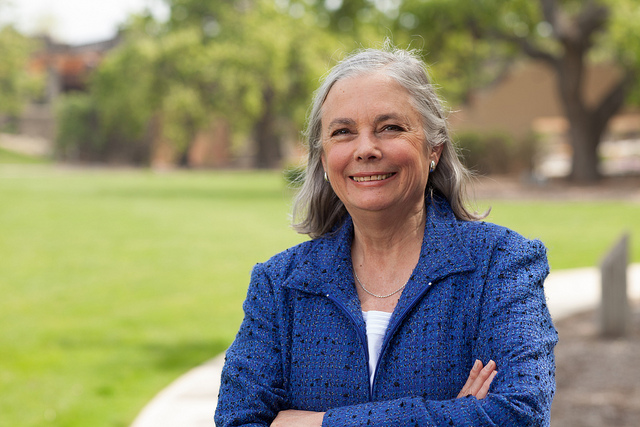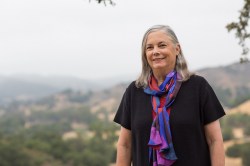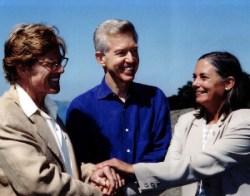There may be no state legislative race this year more freighted with significance for clean energy than the contest in California’s 27th state Senate district.
That’s where Democrat Fran Pavley, a long-time champion of clean energy, is facing off against Todd Zink, a Republican first-timer backed by a torrent of dirty-energy, and just dirty, money. The same corporate interests that haven’t been able to block or repeal Pavley’s legislative victories now want to punish her for passing them — and send a message to other state legislators who might be getting green ideas.
At stake in the race is not only Pavley’s final term in office (she has said this is the last time she plans to run), but a rare chance for Democrats to take two-thirds of the state Senate, which would at long last provide them the ability to bypass the opposition of state Republicans and manage the state’s budget like adults.
Pavley’s history
There’s probably no one in the U.S. who’s done more for clean energy, for less credit, than Fran Pavley.
As a freshman in the California Assembly back in 2002 (after 25 years as a middle-school teacher), Pavley introduced AB 1493, which required sharp cuts in carbon emissions from passenger vehicles in the state. It was among the first state bills ever targeted directly at greenhouse gases. She navigated the bill through the Assembly with a razor-thin one-vote margin. It went on to a long journey past the Senate, the governor’s desk, the California Air Resources Board, the U.S. EPA, and the U.S. EPA again, but the standards were finally implemented in 2009.
In the intervening years, some 17 other states followed California’s lead and adopted the same standards. It effectively created two sets of fuel-economy standards in the U.S., one for Pavley states, one for other states. It drove auto companies mad. That’s what got them to the table to negotiate the national fuel-economy standards Obama finalized this year.
The first meaningful increase in auto efficiency standards in 30 years and Obama’s biggest contribution to the climate fight, and it traces back directly to a freshman state legislator. Kinda crazy.
Pavley’s other historic accomplishment is AB 32, the “Global Warming Solutions Act of 2006,” which puts in place a carbon-reduction goal for California of 25 percent by 2020. You’ll recall that back in 2010, AB 32 was the target of an enormous repeal effort: Proposition 23, backed by Big Oil money from all over the country. It failed, and on Jan. 1 of 2013, California will implement its groundbreaking climate program. It includes a cap-and-trade program, but fully 80 percent of the carbon reductions will come from its accompanying suite of new rules and regulations.
AB 32 would also go on to be a model for national legislation, though in that case — the Waxman-Markey climate bill — the effort fell short.
If it were a country, California would be the world’s 12th largest emitter of carbon. Its climate program is big deal, a pioneering experiment and a positive signal to the rest of America that progress is possible. And it traces back to Pavley.
Pavley has also passed bills on a number of other environmental, public-health, and consumer issues, but if these two — AB 1493 and AB 32 — were the only things she’d ever done, she’d go down in history.
The Senate supermajority
In 1979, a ballot initiative passed that amended the California state constitution, requiring that any bill that increased taxes must pass with a two-thirds majority vote in the legislature.
It is an insane way to run a state budget, guaranteeing gridlock and dysfunction, and that’s just what California has gotten. Its population, economy, state employee pensions, and healthcare costs are all growing, but the Republican minority in the Senate has determinedly blocked all attempts to raise more revenue. (If you think the national Republican Party has gone nuts, it’s nothing compared to the extremism and incompetence causing what The New York Times called the Cali GOP’s “cycle of decline.”)
If they want to avoid vicious cuts to state education and infrastructure budgets, and invest in the state’s future, Democrats will need to win an opposition-proof two-thirds of the Senate, something they haven’t done since Lyndon Johnson was president. (In the Assembly, Dems have occasionally been able to get votes from moderate Republicans, but the GOP senators are hardcore ideologues.) This year, however, getting two-thirds of the Senate is a real possibility. Last year, an independent committee established by Gov. Arnold Schwarzenegger implemented a redistricting plan that created several new swing districts, which are now being hotly contested by extremely well-funded Democratic candidates. The GOP’s finances, meanwhile, are a mess.
To get to two-thirds, Dems need to pick up two seats, a fight that has come down to three close races. The most important, the one that’s seen the highest level of spending on both sides, is Pavley’s.
Money bomb

Todd Zink
When she was in the Assembly, and later when she moved to the state Senate, Pavley was running out of the comparatively safe 23rd district. However, the recent redistricting put her in the 27th, which straddles left-leaning western Los Angeles County, where she is very popular, and right-leaning eastern Ventura County, where … not as much. That has put her in a tight race with Republican Todd Zink, a deputy district attorney in Los Angeles County, member of the Marine Corps Reserve, and novice politician with generic conservative views (lower taxes, fewer services, etc.).
The corporatist right smells blood and is pouring money into the effort to defeat her. Pavley has more money in her campaign coffers than Zink, thanks to the preponderance of Democrats in the state, the cash-rich state Democratic Party, and the help of friends like green venture capitalist John Doerr, director Steven Spielberg, and actor/activist Robert Redford.
But much of the action in the race is around independent groups that have *cough* no connection to the *cough* campaigns. Even before Citizens United, California was awash in unregulated third-party spending. Independent groups have dropped $5 million on state legislative races since the beginning of August, over 20 percent of it — more than $1 million — on the Pavley-Zink race.
Reporter Timm Herdt at the Ventura County Star has done great reporting on the third-party money being spent in the 27th. He says:
It’s easy enough to determine where the money is coming from to support Pavley: $494,054 from the California Teachers Association Independent Expenditure Committee and $28,000 from the California League of Conservation Voters PAC.
The source of the nearly half-million dollars spent to oppose Pavley is a little murkier.
The reason it’s murky is that PACs can pass money around among themselves, obscuring its origin. For instance, the top spender against Pavley is the “California Senior Advocates League PAC.” A group that advocates for seniors? Er, no. Herdt dug into the group’s connections and found funding from Philip Morris, the California Chamber of Commerce, the National Association of Realtors, and best of all, Chevron:
I … found myself doing a maneuver I called the “Chevron Four Step.” It went like this: Chevron gives $375,000 to JobsPAC, which then gives $250,000 to the California Now Independent Expenditure Committee, which then gives $220,000 to the California Senior Advocates League, which then spends $400,000 on state Senate races.
Another PAC donor? The Koch brothers. And speaking of that dynamic duo, Koch Industries dropped a friendly $2,000 [PDF] directly in Zink’s account earlier this month.
The latest bit of sleaze launched by the California Senior Advocates League PAC is an ad claiming that Pavley has paid no taxes on her “six-figure salary.” It is, needless to say, baseless. (It’s about per diems paid to all state legislators for room and board when they stay in Sacramento, around $1,300 a month for Pavley.) Pavley’s campaign has asked Time Warner Cable to pull the ads, but the damage is likely done by now.
Of course, the voters who see those ads (or the equally sleazy mailers) attacking Pavley have no idea that they’re being spun by Chevron. They just see unaccountable negative advertising, constantly. A bill was introduced in the legislature last year that would require independents to list their top three “identifiable contributors.” It needed a two-thirds supermajority and fell short by two (Republican) votes. So you better believe Chevron and Philip Morris don’t want a Dem supermajority this year. (See here for the latest on the fight for transparency in California.)
Pavley had a solid lead over Zink back in July, but as far as I can tell, no polling has been done since, and it’s only recently that the Chevron money has started rolling in. Zink beat Pavley in the open primary in June, although Dems outnumber Republicans in the 27th 41 to 34 percent. At this point, it’s anyone’s race.
Pavley has plenty of friends in the California business community — she’s as responsible as anyone for the explosive growth in the state’s cleantech industries. Some $2.8 billion in cleantech venture capital flowed into the state last year; the clean economy employs more than 21,000 people in California. As Pavley is fond of saying, the state and national Chambers of Commerce hate her, but plenty of local ones love her.
Pavley is an incumbent with name recognition and a track record. She’s been endorsed by the Ventura County Star and the Los Angeles Daily News. Those are big advantages. But she’s also got a target on her back and a long list of corporate CEOs who would like nothing more than to take out a high-profile advocate for clean energy. The outcome of this race will resonate far past California’s borders.





